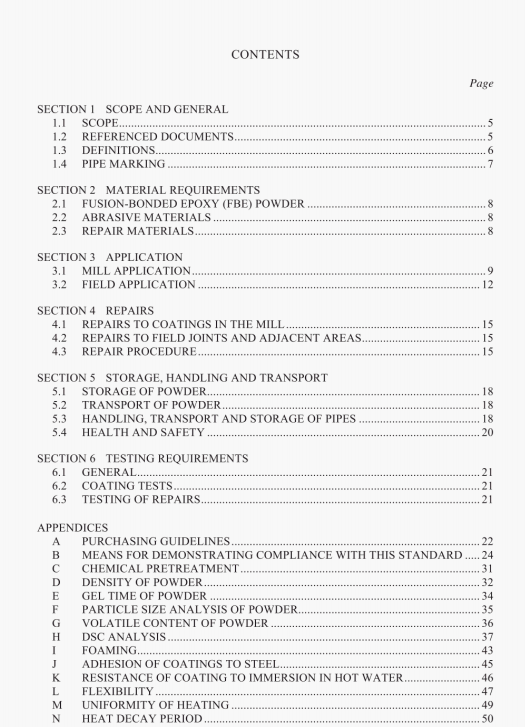AS 3862:2002 pdf – External fusion-bonded epoxy coating for steel pipes.
(e) Any mill-applied coating or repaired coating adjacent to the field joint that is damaged or blistered during the heating process shall be repaired. If blistering occurs in the parent coating, a modified heating rate, which does not promote the blistering, shall be determined and used.
NOTE: Blistering may occur in the parent coating if it is heated too rapidly. The problem is intermittent, and is not related to particular FBE powder types, coating thickness, or pipe properties. The cause of the problem is thought to be the rapid escape of absorbed water from the parent coating.
3.2.7 Application of FBE powder
The following applies to the application of FBE powder:
(a) The powder shall be applied to the pipe surface by spray. The resulting cured film thickness shall be 400 im mm.
NOTE: The minimum thickness required will depend on the performance of the particular powder being used, pipeline operating conditions, pipeline route terrain and many other factors. Accordingly, minimum coating thickness should be that specified by the purchaser for the particular end use being considered.
(b) The coating shall be applied over the entire bare steel area and with a minimum overlap of 25 mm on the adjacent mill-applied coating. The field-applied coating shall completely cover all mill coating abraded during surface preparation with a minimum overlap of 5 mm on untouched mill-applied coating. The overlap coating shall fuse with the substrate coating for a minimum of 20 mm, when tested with a knife. Additional controls may need to be applied to the preheating rate and duration to achieve this condition.
(c) Powder application equipment shall be completely cleaned before and after each day’s work.
3.2.8 Post-application heating
Post-application heating may be used to complete the curing of the coating.
The coated joint shall not be subject to a curing temperature in excess of 260°C and shall be in accordance with the powder manufacturers’ specifications or written instructions.
NOTE: Prolonged elevated temperatures will result in degradation of the coating.
(b) The maximum single area to be repaired shall be 0.01 m2.
(c) The maximum total area to be repaired on one joined pipe shall be 0.1% of the total external surface area of the coated length of pipe.
(d) For any individual pipe length, the number of holidays shall not exceed the rate of 1 per metre of pipe length.
(e) There shall be no more than 50 repairs on any 10 consecutive pipes.
(f) Repairs shall be carried out in accordance with Clause 4.3.
(g) If any of the criteria described in Item(b), (c) or (d) is exceeded, the length of pipe shall be stripped and recoated.
(h) The repaired area shall be subject to a holiday test in accordance with AS 3894.1.
4.2 REPAIRS TO FIELD JOINTS AND ADJACENT AREAS
Field joints and adjacent areas shall be subject to repairs as follows:
(a) All holidays defined in Clause 3 detected on coated field joints shall be repaired in accordance with Clause 7.3. Visible coating discontinuities not detected electrically shall also be repaired in accordance with this Standard.
AS 3862:2002 pdf – External fusion-bonded epoxy coating for steel pipes
